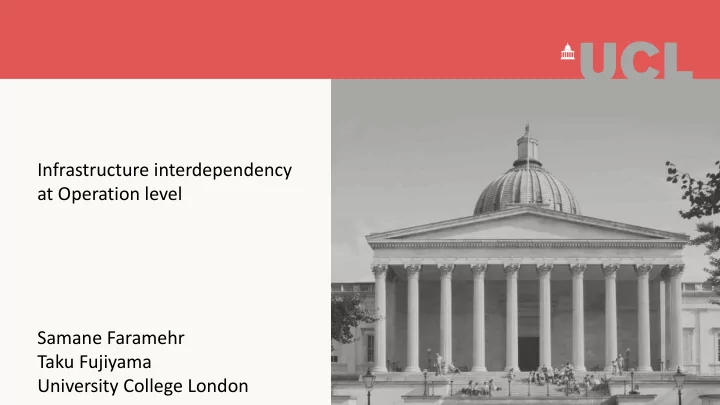

Infrastructure interdependency at Operation level Samane Faramehr Taku Fujiyama University College London 1
Introduction Interdependency of Infrastructure • Many studies on existing and obvious interdependencies (e.g. electricity power supplies to other infrastructure (rail)) • Limited knowledge on – How one system is affected by another through unexpected means – How users embrace challenges and change behaviours, which leads to transformation of society • Research needs – Numerical tools to empower practitioners 2
This presentation • Evaluation of dependency between urban water supply and railway: The scenario of track flooding caused by water main burst Samane Faramehr • Interdependencies between power supply industry and Railways Taku Fujiyama 3
EVALUATION OF DEPENDENCY BETWEEN URBAN WATER SUPPLY AND RAILWAY: THE SCENARIO OF TRACK FLOODING CAUSED BY WATER MAIN BURST 4
Background • Infrastructure systems and interdependency • Normal state of operation vs disrupted state • Risk management strategies • Scenario of track flooding (high consequence) 5
Scenario and the case study • Past incident: Thameslink track flooding (Jan 2015) • Thameslink: between Farringdon and Kentish Town • Railway track through cuts and tunnel • Immature drainage asset inventory (Network Rail) • Railway gradient (Network Rail) • Adjacent trunk water mains (Thames Water GIS data) 6
Methodology • Sub-scenario development • Numerical simulation Railway asset and operation • Hydraulic calculation • Input (parameters) Sub-scenarios • Ballast and local drainage / Input • Railway flooding criteria Quantified results Boundary Sub-scenarios / Input Water main network 7
Results Rail Height= 0.159 m Flat bottom standard rail (UIC54) Criteria of track flooding Flood caused by trunk main burst 8
Results • Distance between the burst and the lowest point 9
Results • Age of track ballast (new vs fouled ballast) 10
Application Railway asset and operation Railway industry Sub-scenarios Risk prioritisation / Input Quantified results Interdependency Boundary Sub-scenarios / Input City level GIS Water companies Water main network 11
Background • Infrastructure systems and interdependency • Risk management strategies • Scenario of track flooding 12
Scenario and the case study • Past incident: Thameslink track flooding (Jan 2015) • Thameslink: between Farringdon and Kentish Town • Railway track through cuts and tunnel • Immature drainage asset inventory (Network Rail) • Railway gradient (Network Rail) • Adjacent major water mains (Thames Water GIS data) 13
Methodology • Sub-scenario development • Numerical simulation Railway asset and operation • Hydraulic calculation • Input (parameters) Sub-scenarios • Ballast and local drainage / Input • Railway flooding criteria Quantified results Boundary Sub-scenarios / Input Water main network 14
Application Railway asset and operation Railway industry Sub-scenarios Risk prioritisation / Input Quantified results Interdependency Boundary Sub-scenarios / Input City level GIS Water companies Water main network 15
Results Rail Height= 0.159 m Flat bottom standard rail (UIC54) 16
INTERDEPENDENCIES BETWEEN POWER SUPPLY INDUSTRY AND RAILWAYS 17
Background • Coal/biomass power stations concentrated in North Lincolnshire with Immingham being the major import port • Critical rail section around Immingham • Quantification of risk is required 18
Critical rail infrastructure in Critical Section 19
This Project • Develop a Data system to capture and store of Network Rail’s Data feeds (and power station outputs) • Data includes • Origin (time, day) • Destination (time, day) • Tonnage • Data Analysis to understand coal/biomass flow to power stations 20
Results: Biomass flow Production at Drax Biomass 3000000 Plants 2500000 2000000 1500000 1000000 500000 0 Oct-16 Nov-16 Dec-16 Jan-17 Feb-17 Mar-17 Apr-17 May-17 Jun-17 Jul-17 Aug-17 400 350 300 250 200 Number of Biomass 150 100 trains to Drax 50 0 Oct-16 Nov-16 Dec-16 Jan-17 Feb-17 Mar-17 Apr-17 May-17 Jun-17 Jul-17 Aug-17 21
Results: Coal flow 30000000 Production at Drax 25000000 Coal Plants 20000000 15000000 10000000 5000000 0 Oct-16 Nov-16 Dec-16 Jan-17 Feb-17 Mar-17 Apr-17 May-17 Jun-17 Jul-17 Aug-17 120 Number of Coal trains 100 80 to Drax 60 40 20 0 Oct-16 Nov-16 Dec-16 Jan-17 Feb-17 Mar-17 Apr-17 May-17 Jun-17 Jul-17 Aug-17 22
Where does biomass to Drax come from? Hull Biomass LP (DBS) 10% Liverpool Biomass TML GBF Immingham 26% Biomass LP (DBS) 64% Data: Aug 2017 23
Where does coal to Drax come from? Hunterston Rylstone Killoch Others Greenburn GBRf H.L GBRF Tilcon (GBRf) Colliery 2% 2% 2% 2% GBRf Tunstead Sdgs 1% Hull Coal 3% Terminal (GBRF) North Blyth GBRF 3% 4% Tyne Coal Ferrybridge Pwr Terminal GBRf Stn GBRf 36% 11% Immingham Humber Import Terml 34% Data: Aug 2017 24
Conclusion • UCL attempts to create numerical tools/discussions on infrastructure interdependencies • Scenario development is key. Comprehensive evidence- or data-based development of scenario development • Scenarios that consider (or focus on) transformation 25
Recommend
More recommend